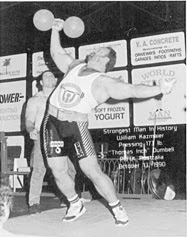I was going to do the 50/20 post as the next part of the simple progressions series, but wanted to share this idea with someone and as I was typing it up, it became far too convoluted for a forum post.
There are plenty of great progressions for training with barbells, and some good ones for kettlebells, odd objects, and bodyweight as well (see the aforementioned post on 50/20 for an example). But there's not much about progressing effectively with dumbbells--and I think that the ability to progress in 5-pound increments (but not smaller, usually) creates an interesting challenge for increasing the weight used.
In the gym, most guys seem to progress by way of their spotters or training partners. If you can seated press 70s but not 75s, have your partner give you a bit of an assist at first, and in a few weeks you might be able to do the 75s on your own. However, for the guy or gal training alone at home, this isn't as much of an option.
So, here's a plan that takes advantage of a dumbbell's adjustability and does its best to get around the fact that, for upper body work, a 5-pound increase per hand can be a bit tough to deal with. It's primarily designed for presses but I suppose it would work for curls, rows, etc. as well. Probably not so well for lower body work, but there are other progressions you can use that work quite well for dumbbell deadlifts (which are a great overall lower body exercise, by the way, if all you have is a pair of heavy, plate loading dumbbells):
...I do recommend that you get a pair more adjustable than Mike's here.
You'll be training 3 nonconsecutive days each week, and working with a different number of repetitions each time.
Day 1: 5x4
Day 2: 4x8
Day 3: 3x12
Thus, you'll be working with a different weight each day. You'll definitely have at least one, maybe two 5-pound jumps in between--if you can press a pair of 55s for 8 you can probably do at least 60s for 4.
Sets will be done in a descending format. Thus, you start with the most weight you can move for the prescribed number of reps, and decrease as needed for the succeeding sets. Thus, your day one session might look like this--(after warmups) 60sx4 (not too bad), 60s x4 (was very hard), 55s x4 (pretty easy), 55s x4 (hard), 50s x4 (very easy). Your day 3 session might be 45s x12, 40s x12, 35s x12, or something like that.
Progression is simple. Add weight to your downsets each time. So, 60x4, 60x4, 55x4, 55x4, 50x4 might become 60x4x2 sets, 55x4x3 sets, and then 60x4x3 sets, 55x4x2 sets, then 60x4x4 sets, 55x4x1 set, and finally 60x4x5 sets. When you can handle the same weight for all the sets, increase the weight, i.e. start with 65s for your first set (and maybe second or even third if you feel good). If you miss a targeted rep, don't worry, just drop down a notch on the next set and try to get it next time. Some of your backoff sets will be easier than others, that's fine. Just hit the targeted reps with good form and keep the weight the same for the next set(s) until it gets really hard, then decrease the weight again.
To give credit, I got this idea from powerlifting extraordinaire Ken Fantano, by way of Marty Gallagher's book The Purposeful Primitive. When doing inclines with 140+ pound dumbbells, he couldn't increase the weight after hitting a certain number of weights for one set (obviously) so he added more backoff sets and gradually increased their weight instead. Three weekly sessions give you plenty of practice, and working with different weights help keep you from stalling, getting mentally or physically stuck with a certain poundage (there have been whole programs written around 'rotating poundages' ideas like this, Leo Costa's OTS III is one of them).
Training multiple times in one week should be fine with dumbbell stuff, again, I got this idea when thinking about overhead presses, and thrice weekly should be fine for those. It would probably work for bench variants too, dumbbells are a bit more shoulder friendly than a barbell. I'm not sure why someone would want to do 3 heavy curling days each week, but this would work for curls as well. Either way, just try to make sure your recovery is on point--it ain't smolov, but you will probably find it more demanding than it looks on paper.
As for the lower body, doing pistol squats one day and dumbbell deadlifts the next, EDT style, should work pretty well. Pullups and ab work can be done after the dumbbell presses; and that's a complete program right there!
So--there you have it. A simple, basically foolproof method for moving up a few dumbbell sizes without microplates, a legion of training partners, or other shenanigans. I doubt you'll be out-pressing Kaz anytime soon, but now you have no excuse not to try....
Kaz with the Inch Dumbbell--173 pounds with a 2 1/2 inch handle.
As always, I hope you enjoyed this post and found something useful to apply to your own training. Questions and comments can be posted below or emailed to me at affectinggravity@gmail.com.

No comments:
Post a Comment